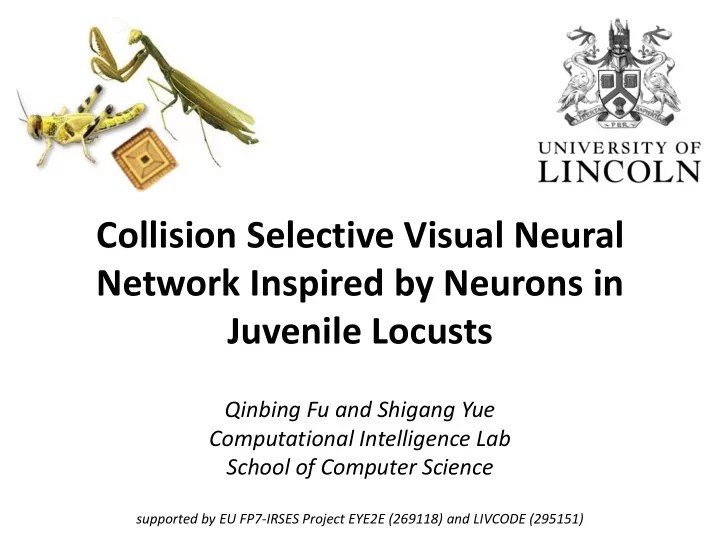

Collision Selective Visual Neural Network Inspired by Neurons in Juvenile Locusts Qinbing Fu and Shigang Yue Computational Intelligence Lab School of Computer Science supported by EU FP7-IRSES Project EYE2E (269118) and LIVCODE (295151)
Research Interests • Neuroscience: Neural Networks (SNN), Visual Pathway (ON/OFF) • Computer Vision: Bio-inspired Visual NN (LGMDs, EMDs, DSNs, STMDs) – Motion Detectors inspired by insects • Robotic Application (Colias) • Machine Learning (CNN, DL)
Motivations • To simulate the juvenile locusts on the ground responding to the predators from the sky • To realize particular collision selectivity, btw solve the defects of LGMD1 computational models. • A robust and cheap looming objects detector
LGMDs Morphology
Network
Core • Low-level Image Feature Processing • Differential Image • No object recognition, scene analysis, even edge detection • A Biased ON and OFF Dual-Channel • ON – luminance increments, OFF – luminance decrements • Separate signal flows, filter, then fuse • A game race between Excitatory and Inhibitory flows • Only sensitive to Light-to-Dark luminance change • Highly Non-linear Signal Processing • Outputs – Firing Rates of Exponential Distribution
EXPs Simulated Stimulus
EXPs Simulated Stimulus
Recorded Stimulus
Colias Tests What is Colias seeing? In Arena Watch Videos
Colias Feedback Continue……
Continue……
Distance to Detect Collision
Conclusion • Perform well in arena with many obstacles • Able to detect looming objects against bright background selectively while not responding to objects in dark background • Practical for ground mobile robots and Cheap cost
Future Work • ON/OFF for Directional Motion Detectors • Data Training • SNN
Thank you!
Recommend
More recommend